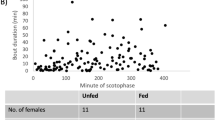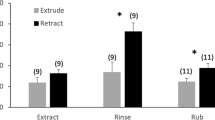Males of the cerambycid beetle Neoclytus acuminatus acuminatus (F.) assume a body posture, never displayed by females, that appears to be associated with release of an aggregation pheromone: they periodically stop walking and fully extend their front legs, elevating their head and thorax above the substrate. In this article, we demonstrate that this body posture, the “pushup stance,” coincides with release of pheromone and that it serves to elevate pheromone glands above the substrate. We also use a pheromone proxy system (sublimation of naphthalene) to demonstrate that the pushup stance increases rates of pheromone dissemination. The pushup stance provides a convenient indictor for studying the role of pheromones in reproductive behavior and facilitating collection of pheromone in the laboratory.




Similar content being viewed by others
REFERENCES
Connor, W. E., and Best, B. A. (1988). Biomechanics of the release of sex pheromone in moths: effects of body posture on local airflow. Physiol. Entomol. 13: 15–20.
Crawshay, G. A. (1907). The life history of Tetropium gabrieli. Trans. Entomol. Soc. London 13: 183–212.
Greenfield, M. D. (2002). Signalers and Receivers: Mechanisms and Evolution of Arthropod Communication, Oxford University Press, NY.
Hardie, J., and Minks, A. K. (eds.). (1999). Pheromones of Non-Lepidopterous Insects Associated with Agricultural Plants, CABI Publishing, Wallingford, United Kingdom.
Iwabuchi, K. (1986). Mating behavior of Xylotrechus pyrrhoderus Bates (Coleoptera: Cerambycidae). III. pheromone secretion by male. Appl. Entomol. Zool. 21: 606–612.
Lacey, E. S., Ginzel, M. D., Millar, J. G., and Hanks, L. M. (2004). Male-produced aggregation pheromone of the cerambycid beetle Neoclytus acuminatus acuminatus. J. Chem. Ecol. 30: 1493–1507.
Leal, W. S., Yadava, C. P. S., and Vijayvergia, J. N. (1996). Aggregation of the scarab beetle Holotrichia consanguinea in response to female-released pheromone suggests a secondary function hypothesis for semiochemical. J. Chem. Ecol. 22: 1557–1566.
Linsley, E. G. (1964). The Cerambycidae of North America, Part V. Taxonomy and classification of the subfamily Cerambycinae, tribes Callichromini through Ancylocerini. Univ. Calif. Publ. Entomol. 22: 1–197.
Millar, J. G., and Haynes, K. F. (1998). Methods in Chemical Ecology: Volume 1, Kluwer, NY.
Moore, P., and Crimaldi, J. (2004). Odor landscapes and animal behavior: Tracking odor plumes in different physical worlds. J. Marine Systems 49: 55–64.
Nakamuta, K., Sato, H., and Nakashima, T. (1994). Behavioral and morphological evidence for a male-produced sex pheromone in the cryptomeria twig borer, Anaglyptus subfasciatus Pic (Coleoptera: Cerambycidae). Jpn. J. Entomol. 62: 371–376.
Noldt, U., Fettköther, R., and Dettner, K. (1995). Structure of the sex pheromone-producing prothoracic glands of the male old house borer, Hylotrupes bajulus (L.) (Coleoptera: Cerambycidae). Intl. J. Insect Morphol. Embryol. 24: 223–234.
Quennedey, A. (1998). Insect epidermal gland cells: Ultrastructure and morphogenesis. In Harrison, F. W., and Ruppert, E. E. (eds.), Microscopic Anatomy of Invertebrates Vol. 11A: Insecta, Wiley-Liss, NY, pp. 177–207.
Ray, A. M., Lacey, E. S., and Hanks, L. M. (2006). Predicted taxonomic patterns in pheromone production by cerambycid beetles. Naturwissenschaften 93: 543–550.
SAS Institute. (2001). SAS/STAT User’s Guide for Personal Computers, Release 8.01, SAS Institute, Cary, NC.
Solomon, J. D. (1995). Guide to insect borers in North American broadleaf trees and shrubs. USDA For. Serv. Agric. Handbook AH-706: 747.
Souza Mendes, P. R. (1991). The naphthalene sublimation technique. Experimental Thermal Fluid Sci. 4: 510–523.
ACKNOWLEDGMENTS
We thank J. B. Nardi and L. A. Miller for assistance with histological sectioning, S. J. Robinson for assisting with SEM, J. G. Millar and J. A. Moreira for providing pheromone standards, and C. Loudon for suggesting the naphthalene sublimation technique as a pheromone proxy system. This research was made possible in part through collaboration with Bugscope, The Imaging Technology Group, Beckman Institute for Advanced Science and Technology, University of Illinois at Urbana-Champaign (http://bugscope.beckman.uiuc.edu/). We appreciate funding support from the Alphawood Foundation of Chicago, US Forest Service under agreement #03-JV-11231300-091, and the Exotic/Invasive Pests and Diseases Research Program, University of California, under USDA-CSREES Grant No. 2004-34439-14691.
Author information
Authors and Affiliations
Corresponding author
Rights and permissions
About this article
Cite this article
Lacey, E.S., Ray, A.M. & Hanks, L.M. Calling Behavior of the Cerambycid Beetle Neoclytus acuminatus acuminatus (F.). J Insect Behav 20, 117–128 (2007). https://doi.org/10.1007/s10905-006-9068-6
Published:
Issue Date:
DOI: https://doi.org/10.1007/s10905-006-9068-6




